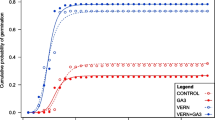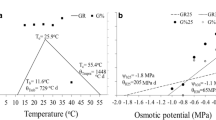Abstract
Carex is a globally distributed genus with more than 2000 species worldwide and Carex species are the characteristic vegetation of sedge meadow wetlands. In the mid-continental United States, Carex species are dominant in natural freshwater wetlands yet are slow to recolonize hydrologically restored wetlands. To aid in Carex revegetation efforts, we determined the dormancy breaking and temperature germination requirements of 12 Carex species. Seeds were cold stratified at 5/1°C for 0–6 months and then incubated in light at 5/1°C, 14/1°C, 22/8°C, 27/15°C, or 35/30°C. We found that all Carex species produced conditionally dormant seeds. The optimal temperature for germination for all but three species was 27/15°C. As is the case in other species with physiological dormancy, cold stratification increased germination percentages, broadened the temperature range suitable for germination, and increased germination rates for most species, but the magnitude of the effects varied among species. Many species germinated to 80% at 27/15°C without cold stratification and at 22/8°C with ≤1 month of stratification but required much longer stratification (up to 6 months depending on the species) to germinate to 80% at 14/1°C and 35/30°C. Our findings illustrate how a stratification pretreatment can greatly benefit Carex seed sowing efforts by triggering rapid germination to higher percentages. We recommend that cold stratification be targeted towards species with strong dormancy or used across a wider range of species when seed supplies for restoration are limiting. For Carex revegetation, establishing Carex canopies rapidly may help to prevent the invasion of undesirable species such as Phalaris arundinacea.


Similar content being viewed by others
References
Analytical Software (2003) Statistix 8.0. Analytical Software, Tallahassee, FL
Barkley TM (ed) (1986) Flora of the Great Plains. University Press of Kansas, Lawrence, KS
Baskin CC, Baskin JM (1998) Seeds – ecology, biogeography, and evolution of dormancy and germination. Academic Press, San Diego
Bernard JM (1990) Life history and vegetative reproduction in Carex. Can J Bot 68:1441–1448
Bohnen JL, Galatowitsch SM (2005) Spring Peeper Meadow: revegetation practices in a seasonal wetland restoration in Minnesota. Ecol Restor 23:172–181
Budelsky RA, Galatowitsch SM (1999) Effects of moisture, temperature, and time on seed germination of five wetland Carices: implications for restoration. Restor Ecol 7:86–97
Budelsky RA, Galatowitsch SM (2000) Effects of water regime and competition on the establishment of a native sedge in restored wetlands. J Appl Ecol 37:971–985
Budelsky RA, Galatowitsch SM (2004) Establishment of Carex stricta Lam. seedlings in experimental wetlands with implications for restoration. Plant Ecol 175:91–105
Burton PJ, Burton CM (2002) Promoting genetic diversity in the production of large quantities of native plant seed. Ecol Restor 20:117–123
Clewell A, Rieger JP (1997) What practitioners need from restoration ecologists. Restor Ecol 5:350–354
Diboll N (1997) Designing seed mixes. In: Packard S, Mutel CF (eds) The tallgrass restoration handbook for prairies, savannas, and woodlands. Island Press, Washington, DC, pp 125–150
Forbes BC (1993) Small-scale wetland restoration in the high Arctic: a long-term perspective. Restor Ecol 1:59–68
Galatowitsch SM, Biederman LA (1998) Vegetation and seedbank composition of temporarily flooded Carex meadows and implications for restoration. Int J Ecol Environ Sci 24:253–270
Galatowitsch SM, van der Valk AG (1996a) Characteristics of recently restored wetlands in the prairie pothole region. Wetlands 16:75–83
Galatowitsch SM, van der Valk AG (1996b) Vegetation and environmental conditions in recently restored wetlands in the prairie pothole region of the USA. Plant Ecol 126:89–99
Galatowitsch SM, van der Valk AG (1996c) The vegetation of restored and natural prairie wetlands. Ecol Appl 6:102–112
Galatowitsch SM, Budelsky RA, Yetka LA (1999) Revegetation strategies for northern temperate glacial marshes and meadows. In: Streever W (ed) An international perspective on wetland rehabilitation. Kluwer Academic Publishers, The Netherlands, pp 225–241
Gleason HA, Cronquist A (1991) Manual of vascular plants of the northeastern United States and adjacent Canada. The New York Botanical Garden, New York
Grabe DF (ed) (1970) Tetrazolium testing handbook for agricultural seeds. Contribution no. 29 to the handbook on seed testing. Association of Official Seed Analysts, Lincoln, Nebraska
Green EK, Galatowitsch SM (2001) Differences in wetland plant community establishment with additions of nitrate-N and invasive species (Phalaris arundinacea and Typha xglauca). Can J Bot 79:170–178
Green EK, Galatowitsch SM (2002) Effects of Phalaris arundinacea and nitrate-N addition on the establishment of wetland plant communities. J Appl Ecol 39:134–144
Grime JP, Mason G, Curtis AV, Rodman J, Band SR (1981) A comparative study of germination characteristics in a local flora. J Ecol 69:1017–1059
Holl KD, Loik ME, Lin EHV, Samuels IA (2000) Tropical montane forest restoration in Costa Rica: overcoming barriers to dispersal and establishment. Restor Ecol 8:339–349
Holmes PM, Richardson DM (1999) Protocols for restoration based on recruitment dynamics, community structure, and ecosystem function: perspectives from South African fynbos. Restor Ecol 7:215–230
Hurd EG, Shaw NL (1992) Seed technology for Carex and Juncus species of the intermountain region. In: Landis TD (ed) Intermountain Nurseryman Association annual meeting. USDA, Forest Service, Rocky Mountain Forest and Range Experiment Station, Park City, UT, pp 74–83
Johnstone IM (1986) Plant invasion windows: a time-based classification of invasion potential. Biol Rev Camb Philos Soc 61:369–394
Jones KL, Roundy BA, Shaw NL, Taylor JR (2004) Environmental effects on germination of Carex utriculata and Carex nebrascensis relative to riparian restoration. Wetlands 24:467–479
Kettenring KM (2006) Seed ecology of wetland Carex spp. – implications for restoration. Applied Plant Sciences. University of Minnesota, St. Paul, 133 pp
Kettenring KM, Gardner GM, Galatowitsch SM (2006) Effect of light on seed germination of eight wetland Carex species. Ann Bot 98:869–874
Leck MA (1989) Wetland seed banks. In: Leck MA, Parker VT, Simpson RL (eds) Ecology of soil seed banks. Academic Press, Inc., New York, pp 283–305
Lindig-Cisneros R, Zedler JB (2001) Effect of light on seed germination in Phalaris arundinacea L. (reed canary grass). Plant Ecol 155:75–78
Martin D, Chambers JC (2002) Restoration of riparian meadows degraded by livestock grazing: above- and belowground responses. Plant Ecol 163:77–91
Maurer DA, Zedler JB (2002) Differential invasion of a wetland grass explained by tests of nutrients and light availability on establishment and clonal growth. Oecologia 131:279–288
Mulhouse JM, Galatowitsch SM (2003) Revegetation of prairie pothole wetlands in the mid-continental US: twelve years post-reflooding. Plant Ecol 169:143–159
Perry LG, Galatowitsch SM, Rosen CJ (2004) Competitive control of invasive vegetation: a native wetland sedge suppresses Phalaris arundinacea in carbon-enriched soil. J Appl Ecol 41:151–162
Schütz W (2000) Ecology of seed dormancy and germination in sedges (Carex). Perspect Plant Ecol Evol Syst 3:67–89
Schütz W, Rave G (1999) The effect of cold stratification and light on the seed germination of temperate sedges (Carex) from various habitats and implications for regenerative strategies. Plant Ecol 144:215–230
Steed JE, DeWald LE (2003) Transplanting sedges (Carex spp.) in southwestern riparian meadows. Restor Ecol 11:247–256
USDA NRCS (2005) The PLANTS Database, Version 3.5. National Plant Data Center, Baton Rouge, LA. http://plants.usda.gov
van der Valk AG, Bremholm TL, Gordon E (1999) The restoration of sedge meadows: seed viability, seed germination requirements, and seedling growth of Carex species. Wetlands 19:756–764
Wijdeven SMJ, Kuzee ME (2000) Seed availability as a limiting factor in forest recovery processes in Costa Rica. Restor Ecol 8:414–424
Zanini L, Ganade G (2005) Restoration of Araucaria forest: the role of perches, pioneer vegetation, and soil fertility. Restor Ecol 13:507–514
Acknowledgments
We thank Carol Baskin, Albert Markhart, Carrie Reinhardt Adams, and two anonymous reviewers for comments on earlier drafts of this manuscript. This study would not have been possible without field and lab assistance from Stacey Olszewski, growth chamber support from Mike Emerick, statistical advice from Christopher Bingham, and funding from a graduate student grant from Applied Ecological Services, a Brand Fellowship from the University of Minnesota Graduate School, a Delta Waterfowl graduate student fellowship, a Dayton Fellowship from the Bell Museum of Natural History, and the University of Minnesota Agricultural Experiment Station to the first author. This is a publication of the University of Minnesota Agricultural Experiment Station.
Author information
Authors and Affiliations
Corresponding author
Rights and permissions
About this article
Cite this article
Kettenring, K.M., Galatowitsch, S.M. Tools for Carex revegetation in freshwater wetlands: understanding dormancy loss and germination temperature requirements. Plant Ecol 193, 157–169 (2007). https://doi.org/10.1007/s11258-006-9255-8
Received:
Accepted:
Published:
Issue Date:
DOI: https://doi.org/10.1007/s11258-006-9255-8




